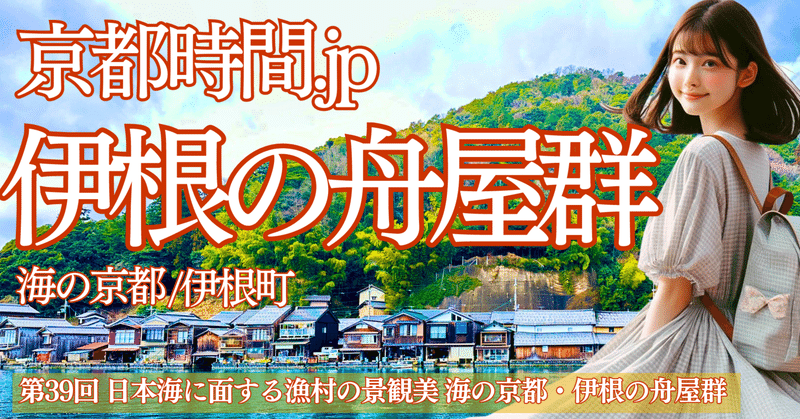
【京都時間.jp】 第39回 日本海に面する漁村の景観美 海の京都・伊根の舟屋群
日本海に面した京都府最北端の伊根町。人口わずか2,000人足らずのこの小さな漁村には、年間30万人を超える観光客が訪れる人気の観光地があります。それが、伊根湾に立ち並ぶ「伊根の舟屋」です。

舟屋とは、もともと漁具や小型漁船を収納するための船倉兼民家のこと。時代とともに居住空間としても使われるようになり、今では重要伝統的建造物群保存地区に選定されています。外観が無骨な木造の船倉が、まるで絵画のように美しく湾に向かって連なる風景は、日本でも稀有な景観美を生み出しています。

この地の歴史は非常に古く、地域内で発見された6世紀末の遺物から、古代から人々の生活の場となってきたことがうかがえます。中世以降は特に漁業が盛んとなり、鯨、鮪、鰹、鰤などを対象に大規模な漁が行われていました。江戸時代に入ると宮津藩の一部となり、漁業はさらに発展を遂げます。しかし同時に、有力者たちの間で漁場を巡る確執も絶えず、捕鯨の開始とともに共同での漁撈の必要性が高まっていきました。

そうした中で育まれていったのが、独自の漁業文化です。共同での漁撈を行い、収益を分配する仕組みである「株組織」がその一例です。一定の資産に応じて株を持ち、船や漁具、操業権を共有。漁獲高に応じて収益が分配される仕組みで、村民の結束を強めることにも繋がりました。株組織の創設は寛文年間(1668~1673年)とされ、以降、改革を重ねながら発展してきました。

明治時代に入ると、新しい漁業法の公布(1901年)や漁業組合の結成(1905年)により、漁業は近代化の道を歩みます。この時期、伊根浦での鰤大敷網漁業が成功を収め、莫大な利益を生み出しました。鰤は高級魚として需要が高く、投資を呼び込む起爆剤となりました。しかし一方で、無株の漁師と有株者の間に新たな格差が生まれるなど、新たな問題も発生しました。

そこで1926年(大正15年)、漁業組合による大規模な改革が行われることになります。共同の漁場における共同操業が制度化され、漁獲高に応じて村民全体で公平に収益を分配する仕組みが実現。地域住民の利害を一つに束ねた、まさに理想的な共同経営体制が確立されたのです。

このように、伊根の人々は自然環境の恵みに加え、独自の知恵と工夫で漁業文化を発展させてきました。舟屋が船倉としてだけでなく居住空間にもなったのも、そうした歴史の賜物です。当初は一時的な居住に過ぎなかった舟屋が、徐々に快適な住まいへと改装されていったのです。船倉の2階部分に板張りの居間や寝室が設けられ、船大工の技術を活かした丈夫で機能的な作りは、耐久性にも優れていました。

木造建築が潮風に染まり、味わいを増した舟屋の風景的価値は高く評価されています。観光資源として年々注目が高まり、多くの人々を魅了しています。海の幸の食事処やくつろげるカフェなども整備されつつあります。。鮮度抜群の海鮮料理を味わえるほか、釣り体験やカヌーなどのアクティビティ(季節限定)にも参加できます。伊根湾に臨む食事処では、漁船が出漁するさまを眺めたり、魚の旨味を存分に感じることができる魚介類をいただけたりできる最高の舌鼓体験が待っています。

海の幸に育まれた風情あふれる舟屋群と、とても穏やかな湾内。日本の原風景とも言えるその情景に、まざまざと漁村の生活が偲ばれます。時を越えて守り続けられてきた、この美しい景観と豊かな文化。日本海に面する海の京都・伊根町で、ぜひ体感していただきたいです。
Ine Town, located at the northernmost tip of Kyoto Prefecture facing the Sea of Japan, is a small fishing village with a population of just under 2,000 people. Despite its size, it attracts over 300,000 tourists annually, thanks to the popular tourist destination known as the "Funaya" (boat houses) of Ine Bay.
A Funaya serves both as a boathouse for storing fishing gear and small fishing boats, and as a residence. Over time, they have come to be used as living spaces as well, and are now designated as an Important Traditional Building Group Conservation Area. The simple wooden construction of the boathouses creates a landscape that lines the bay in a way that is uniquely beautiful, creating a rare scenic beauty in Japan.
The history of this area is very old, with artifacts from the late 6th century found in the region suggesting that it has been a place of human habitation since ancient times. From the medieval period onwards, fishing became particularly active, with large-scale fishing targeting whales, tuna, bonito, and amberjack. With the advent of the Edo period, the area became part of the Miyazu domain, and fishing developed even further. However, this period also saw continuous conflicts over fishing grounds among powerful figures, and the necessity for cooperative fishing increased with the start of whaling.
Amidst these conditions, a unique fishing culture developed. An example is the "Kabu organization," a system where profits are distributed among members who fish cooperatively. Members hold shares according to their assets, sharing boats, fishing gear, and operating rights. Profits are distributed based on the catch, which also served to strengthen community ties. The creation of the Kabu organization dates back to the Kanbun era (1668-1673), and it has evolved through reforms ever since.
With the Meiji era came modernization in fishing, with the enactment of new fishing laws (1901) and the formation of fishing cooperatives (1905). During this period, the success of large-scale purse seine fishing for amberjack in Ine Bay brought immense profits. Amberjack, being a high-demand luxury fish, acted as a catalyst for investment. However, this period also saw new disparities arise between fishermen without shares and those with shares.
In 1926 (Taisho 15), a major reform was undertaken by the fishing cooperative. A system was established for fair distribution of profits among all villagers based on catch, through cooperative fishing in shared fishing grounds. This was essentially an ideal co-management system that unified the interests of the community.
Thus, the people of Ine have developed their fishing culture with their own wisdom and ingenuity, in addition to the blessings of the natural environment. The fact that the Funaya came to serve not only as boathouses but also as living spaces is a testament to this history. Originally temporary residences, the Funaya were gradually renovated into comfortable homes. The second floor of the boathouses was equipped with wooden living rooms and bedrooms, utilizing the durable and functional craftsmanship of ship carpenters.
The landscape value of the wooden Funaya, aged and seasoned by the sea breeze, is highly regarded. As a tourism resource, it has been attracting increasing attention year by year, enchanting many visitors. Additionally, visitors can participate in activities such as fishing experiences and canoeing (seasonal), and enjoy the ultimate culinary experience at restaurants facing Ine Bay, watching fishing boats set out and savoring the deliciousness of seafood.
The Funaya, nurtured by the bounty of the sea, along with the very calm waters of the bay, evoke the original landscape of Japan and remind us vividly of the fishing village life. This beautiful scenery and rich culture, preserved through the ages, is something we hope you will experience firsthand in Ine Town, facing the Sea of Japan, the maritime Kyoto.
この記事が気に入ったらサポートをしてみませんか?
